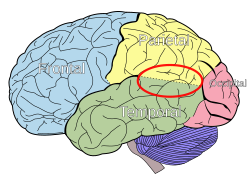Temporoparietal junction
| Temporoparietal junction | |
|---|---|

Side view of the human brain. TPJ is indicated by red circle.
|
|

Side view of the human brain. TPJ is indicated by red circle.
|
|
| Identifiers | |
| Acronym(s) | TPJ |
| NeuroLex ID | Temporoparietal junction |
|
Anatomical terms of neuroanatomy
[]
|
|
The temporoparietal junction (TPJ) is an area of the brain where the temporal and parietal lobes meet, at the posterior end of the Sylvian fissure. The TPJ incorporates information from the thalamus and the limbic system, as well as from the visual, auditory, and somatosensory systems. The TPJ also integrates information from both the external environment as well as from within the body. The TPJ is responsible for collecting all of this information and then processing it. This area is also known to play a crucial role in self-other distinctions processes and theory of mind (ToM). Furthermore, damage to the TPJ has been implicated in having adverse effects on an individual’s ability to make moral decisions and has been known to produce out-of-body experiences (OBEs).Electromagnetic stimulation of the TPJ can also cause these effects. Apart from these diverse roles that the TPJ plays, it is also known for its involvement in a variety of widespread disorders including amnesia, Alzheimer's disease, and schizophrenia.
The brain contains four main lobes: temporal lobe, parietal lobe, frontal lobe and the occipital lobe. The temporoparietal junction lies in the region between the temporal and parietal lobes, near the Sylvian fissure. Specifically, it is composed of the inferior parietal lobule and the caudal parts of the superior temporal sulcus. There are two halves to the temporoparietal junction, with each component in their respective hemispheres of the brain. Each half of the TPJ pertains to various aspects of cognitive function. Often, however, the separate halves of the TPJ will work in coordination. The TPJ is mainly involved in information processing and perception.
...
Wikipedia
